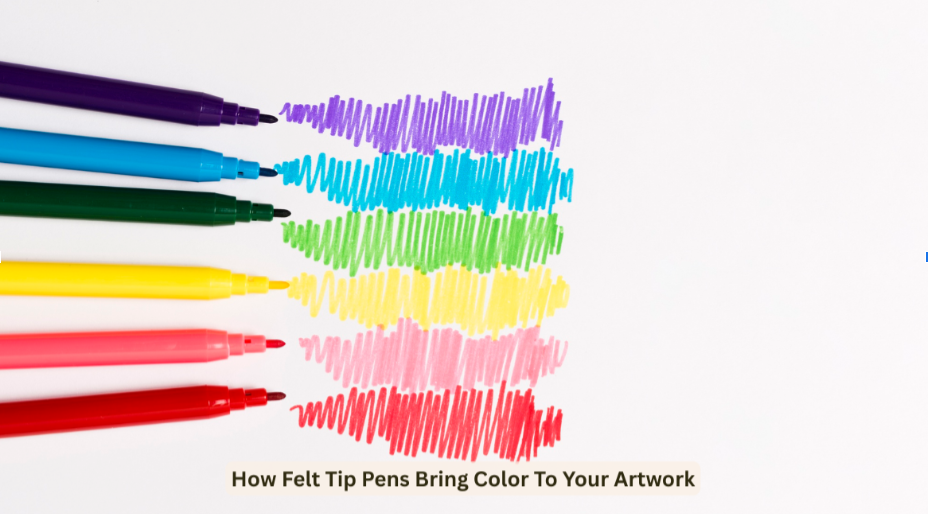
How Felt Tip Pens Bring Color To Your Artwork
Color is one of the most compelling elements of art. It can set the mood, draw attention to detail, and help your artwork zing. The felt-tip pen is one of the easiest and most fun tools for creating color. They are straightforward to use, ready to go when you remove the cap, and available in a broad spectrum of colors.
Unlike paints or pastels, felt-tip pens need no other tools or messy preparation. You don’t have to set out brushes, water, or palettes. You take up the pen and start. Felt-tip pens are perfect for quick sketches, classroom work, detailed illustrations, or home coloring projects.
This article explores how felt-tip pens add color to your work and how to achieve the best from them.
1. Different Tips And Sizes Add Variety To Your Artwork
Perhaps the most important means by which felt-tip pens color your work is through the variety of tip sizes and styles. Broad tips are best for coloring large areas effectively, like poster backgrounds or heavy poster lettering. Delicate tips are best for thin lines, outlines, or small quantities of decorating details. Some even have brush-type tips that draw different line thicknesses depending on how you hold them.
Selecting the proper felt-tip pens considerably impacts the appearance of your colors. A wide tip will provide strong, solid coverage with no streaks, whereas a fine tip can add sharp outlines or subtle details. Most artists stock both to alternate between large areas and fine details easily.
The hardness and shape of the tip also affect how the color works on the page. The soft tips make for smoother coverage, and the firmer tips result in more defined lines. Messing around with options will help you decide which ones you like best.
2. Smooth Ink Flow Creates Even, Bold Color
Felt-tip pens are loved for their smooth, consistent ink flow. Ink is applied directly from the tip onto the paper and gives you a neat, even color. This means you can get a smooth finish without gaps or patchiness.
Using smooth, overlapping strokes prevents lines from forming when coloring large areas. If streaks are seen, color in small circles instead of straight lines. This better blends the ink and gives a richer, smoother look.
The paper you write on is also critical. Smooth paper enables the ink to flow and spread out evenly, resulting in beautiful, bold color. Thicker paper will suck up the ink too fast and give you uneven lines. Write with your felt-tip pens on good-quality paper or the same-colored cardstock as your project for maximum performance.
3. Layering And Blending Build Depth And Shade
Remember, felt-tip pens aren’t just for flat, single-color areas. You can layer them up to obtain deeper, darker colors. Please start with the first thin layer, then add a second one over it to create a darker color. Light pressure on the first layer and increased pressure on the second one will make a subtle gradation of tone.
Blending works best when the ink is still damp. Work with one color, then position another next to it and have the edges touch. This will mix the two colors nicely and add depth to your work.
You may also use layering for pattern and texture. For example, fill an area with light blue, then layer darker blue dots or lines over this to create the illusion of water or waves. Adding shadows using a slightly darker shade of the same color can create a three-dimensional effect on shapes.
See also: Best Thai Restaurant in Media City Dubai

4. Mixing With Other Materials Expands Creative Effects
Another way that felt-tip pens contribute color to your artwork is by using other art materials. They can be used alongside pencils, paint, markers, or even collaged elements to create mixed-media art.
One popular technique is sketching and defining in bold with felt-tip markers and subtly shading with colored pencils. You can also watercolor a background and add details with felt tips on top once it is dry. Felt tips can be combined with metallic markers for a sparkling highlight and accent.
Felt-tip pens are also well-suited for collage work. They may be used to mark paper shapes in color before they are cut, or to create borders and designs around adhered pieces. They are so adaptable that they become the natural choice for all but the most unique craft project.
Mixing media lets you combine the sharp brightness of felt tips with the texture or effects of another tool.

5. Proper Care Keeps Colors Bright And Pens Ready
To keep your felt-tip pens working well, you need to take care of them. Always put the cap back on tightly after use to prevent the ink from drying out. Store them flat to keep the ink even, or tip-down if they start to feel dry.
Don’t press too hard when drawing; this can damage the tip and make the color uneven. A light touch will give you cleaner lines and help your pens last longer. Please keep them in a cool, dry place away from direct sunlight so the ink stays fresh and bright.
Organizing your pens by color or size makes them easier to use. Your creative process flows more smoothly when you can quickly find the shade you want.
With the right care, your pens will keep giving you bright, even color for many projects.
Final Thoughts
Felt-tip pens are probably the simplest and most effective way of adding color to your work. They come in a wide range of tip forms and sizes, deliver smooth coverage, can be layered and mixed, and are used to excellent effect with other media. Treated with care, they will stay bright and await each idea you want to develop.
Whether rendering detailed drawings, dramatic posters, or coloring a coloring book, felt-tip pens easily bring color and excitement to your work. If you want to explore their artistic possibilities, a great set of felt-tip pens is a great place to start.




